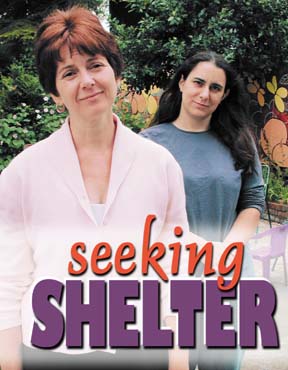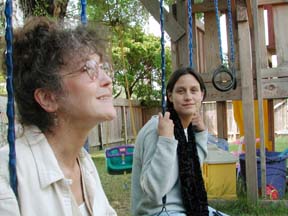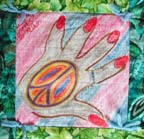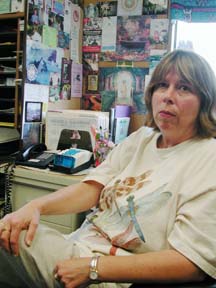|  
IN THE NEWS | IN THE GARDEN | CALENDAR

Elizabeth Thompson, interim executive director and Alexandra Micheals, administrative assistant and fund-raiser
for Humboldt Women for Shelter
by GEORGE RINGWALD
The felicitously named Wish House in Garberville, a sanctuary for victims of domestic violence, Marilyn Bowen works the crisis line. "We have many cases of people being battered," she says. Still, a lot of people don't want to report their batterings. "Women don't want the police being called," she explains. Carin Engen, public relations person for the past four years, says the situation hasn't changed much over the years. "There are still people abusing drugs and alcohol, and as long as you have that, you're going to have domestic violence. Marilyn is so good at her job; she really relates to the victims." Parenthetically, she adds: "We call them `survivors.'" Bowen, now in her 50s, said matter-of-factly in a recent telephone interview with the Journal: "I was battered myself." ("Most of us are," confides a staff worker at the Humboldt Women for Shelter in Eureka.) Thirty-five years ago Bowen was married to a man she learned was a paranoid schizophrenic. "He beat me pretty good," she recalls. "When he hit my son, that's when I lost it." One day when he passed out (caused by the mental problem), she got together the tips she'd saved from her waitress job, packed up and took off. "I got three counties away," she related, "and still he tracked me down. He kidnapped my two kids. He took them to Mexico -- he's of Mexican descent himself." They were legally divorced in 1976. Bowen signed the divorce papers on condition that she could see her children. But her two sons, now grown men, carry the scars of the childhood abuse. As Bowen says, "Basically, they grew up being abused by him, and they're unhappy men. Just real negative." The scars of domestic violence are long-lasting, and, indeed, they mark the lives with cruel impartiality of all concerned -- children, women and the batterers themselves.  A high rate of domestic violence A high rate of domestic violence
Patricia Samson, program director of Eureka's Humboldt Women for Shelter [at left in photo with Angelique Velasco, crisis services coordinator], said there's a clear need for the shelter and not just for women. "We obviously have a great number of women here, but not women exclusively." "That's right," puts in Alexandra Micheals, administrative assistant and fund-raiser for the shelter. "That's why we're women for shelter, not shelter for women." She goes on: "I think it's becoming more recognized now that domestic violence isn't just a problem with women being battered. Men can be battered by women, men can be battered by other men who are domestic partners, women can batter other women." Elizabeth Thompson, the shelter's interim executive director and its newest member, notes: "Humboldt county has a much greater arrest rate for domestic violence." Indicative of the problem's extent, the shelter last year handled 2,796 telephone calls on the hot line. "Alex," as Micheals is known, said: "The most serious issue in the county obviously is the number of women killed by their domestic partners. [Just recently] there was a woman killed by her domestic partner, and I think within the past 10 years there have been something like 12 murders of women by either husbands or boyfriends or former spouses. That obviously is the ultimate violence, and the sort of thing we're trying desperately to intervene and avoid here." Bill Rodstrom, program coordinator of the Domestic Violence Project in the District Attorney's Office, told the Journal that Humboldt County is about 44 percent higher than the state average for domestic violence cases. Why? "There's a pretty high correlation between poverty rates and domestic violence rates," he replies, "even though very wealthy people can have domestic violence too." He goes on: "I think there is more stress among people who are at lower economic levels. Unemployment rates are usually tied somewhat to domestic violence rates." Thompson makes another point about domestic violence: "What a lot of people don't know is the most dangerous time -- the most hospitalizations, the most murders occur when someone is trying to leave a battering partner. The time in which people need the most careful safety planning, the most shelter services, the most transportation out of the area."  At left: Panel from a quilt made from drawings by children of domestic violence victims. At left: Panel from a quilt made from drawings by children of domestic violence victims.
And yet, as Micheals says: "You often hear people who have no understanding of the issue say things like, `Well, why did she allow this to happen to herself? If somebody hit me, I would just leave. What is her problem?' But that person just doesn't understand the kind of mind state that anybody can get into when day after day they have esteem chipped away until they get to a point where there really is hopelessness about everything they're thinking and feeling. The closest you can really compare it to is brain-washing. "That's why the support group meeting of clients with staff are so important," she says. "They help break patterns of thought that women who attend have," she explains. "Lowered self-esteem. The support groups work on changing this kind of pattern, and on teaching the participants that it's not OK to allow yourself to be battered, that what happens isn't your fault, all the mental litanies that go on in the brains of people who have been abused, particularly over a long period of time." Rebecca Floyd, who formerly worked on the management team at the Humboldt Women for Shelter, said: "We have a very high incidence of domestic violence, and a lot of it goes unreported, down in the south part of the county particularly because of pot growing, and here in the north because of our Native American population out in the boonies. It's very hard for the Sheriff's Department to get out there a lot of times." Since leaving her shelter job in April, Floyd is now chair of the Domestic Violence Coordinating Council for DVERT, an acronym for Domestic Violence Response Team, whose goal is to bring together the various agencies that operate in the domestic violence field here: for instance, North Coast Rape Crisis Team, Humboldt Women for Shelter, Children's Welfare Service, the District Attorney's Office, police and sheriff's departments, Superior Court judges. Floyd acknowledges that DVERT is "not a done deal," meaning it's still in the planning stages. But if anyone's going to do it, she seems a likely prospect. She is an intense, committed woman who isn't afraid to step on big toes and who repeatedly emphasizes the necessity of county-wide action. "Although I think the community is beginning to change," she says, "There has been very little understanding of what domestic violence is really about and how we can go about doing something. The law is not enough, agencies working are not enough; it's gotta be community response. "And truly," spewing out the words rapidly, "this county is being horribly impacted financially by domestic violence." A patriarchal society As a number of other women and men as well have said in Journal interviews, Floyd traces the origin of domestic violence to machismo -- "part of the patriarchal structure of the society that we've been raised with, that a woman is owned by her man. "And even though we may intellectually understand that that's not the way it should be," she continues, "it's always gone that way and that is what domestic violence is about. It's about power and control, and how we value power and control in our society Is it OK for women to be angry? No, it's not. It's not nearly as OK for a woman to be angry as it is acceptable, and in fact probably expected, for men to be angry. And to express that anger in a physical way. We consider that `natural.'" This is what Floyd sees as the wakeup call for the community. "The worst are the judges," she asserts. "The lack of information and knowledge that the judges have is horrifying. Good legal help is essential to victims, and they're not getting it. It's going to take community pressure to get judges interested." Floyd relates that she and District Attorney Terry Farmer once went to the judges "trying to get them to at least put all the domestic violence cases in one court, rather than being spread over five courts, which makes it impossible for agencies who aren't well-funded to begin with -- to try and give court accompaniment to all the women who want it." "Its going to take community pressure to get the judges interested. It's a very tight clique; it's very hard for us to influence them." Another problem has been the law itself -- in particular assault statutes, which mandate a relatively short time period in which to bring charges against a batterer and do not allow victims to sue for attorney's fees. Those shortcomings appear to have been fixed last week when Gov. Gray Davis signed legislation that allows a victim of domestic violence to sue for general, special and punitive damages. The new law, the work of Assemblywoman Sarah Reyes, D-Fresno, also gives courts the power to grant equitable relief, an injunction, costs and reasonable attorney's fees. Floyd turns to a different subject. "The damage done to children in domestic violence situations is horrendous," she says. "Society is breeding a huge generation of men and women being programmed to domestic violence. "And I would think that Humboldt County would be a community that truly embraced this idea of working together to end domestic violence." That's where DVERT comes in -- getting a county-wide awareness through a uniting of agencies to attack the problem of domestic violence. Floyd says, "I would like every victim advocate in the county riding along with police to see what they encounter; I would like to see every deputy DA that works with domestic violence going out with the police; I would like to see police doing volunteer work at the shelter, and begin to experience these women and children; I would like to see the deputy DA have to go down and stand in the social services line with the victim while she tried to get services and money to feed her kids."  One woman, who shall be nameless, tells of her volunteer service working a crisis line in Arcata about 20 years ago. One woman, who shall be nameless, tells of her volunteer service working a crisis line in Arcata about 20 years ago.
"I started hearing their stories, and I was just mortified to think of the things they went through," she recalls. She'd get a call, and would ask: "Are you safe? Can you talk? Sometimes you'd hear screaming in the background. It was scary. "I'll never forget -- a young woman with a baby. She called when she was sure he (the batterer) was gone. She started to move, staging it very carefully. We came by in a car and picked her up. She was just scared to death of this guy." Another time she went out to see a victim at her home. "The apartment was trashed, signs of physical violence all around," she relates. "The woman had a big black eye." That is why she remembers the job as being so scary. The question is put to leaders of the Humboldt Women for Shelter -- do they ever have that feeling of being afraid? "I don't," Patricia Samson responds. "I mean, I'm cautious, I'm careful, but I don't work here with a feeling of fear. In this culture, this time and day and age, I think everyone is aware of, or should be aware of, their surroundings, and what's going on." Elizabeth Thompson puts in: "I think you can't be afraid and work here, because your fear adds to the client's fear." The shelter house, incidentally, has its own safeguard. The location is strictly confidential, as is that of the safe house. Humboldt Women for Shelter Inc., now in its 25th year, is a nonprofit organization, with funds coming primarily through the state, with a little bit of federal money, plus private donations, some county money and even money batterers may be required to pay. Alex Micheals, who just finished the budget for the fiscal year starting in July, reports that "all our funds together will probably total about $480,000." The shelter building and the safe house are leased. "We run a very lean operation here," she says. "Everything that comes in goes right back out." At last count, the shelter had 19 paid staff workers. Restraining orders ineffective? The question comes up about the effectiveness of court-ordered temporary restraining orders against batterers. "There's always the issue of how much difference they make," admits Samson. "The biggest benefit I can see is that if you have one against an individual or the cohabitant, then the police actually can arrest that individual for showing up at your door. But a piece of paper is not going to guarantee that somebody isn't going to do something to you." Micheals adds: "There are always these people whom a restraining order triggers the batterer to be more violent." One encounters these "on the other hand" responses every now and then in the exploration of domestic violence. Rebecca Floyd, for instance, notes that when people started to work on domestic violence, they learned that they couldn't get the victim to testify in court against their batterer. "And the reason you couldn't do that was because you were putting (the victim) in incredible danger." She also evinces her disdain of a justice system that "doesn't even fine correctly," but then adds "the other side of that -- if you actually fine the perpetrators, you're actually fining the women and children involved because it's coming from them." Humboldt Women for Shelter has had some success with its program for victims of domestic violence. "They work for other agencies in the community," said Samson. "You'd be surprised; they come to do trainings and they were once clients of ours. "They stay in touch with us and they can share their stories and encourage people. It's really important to have that network. We have people who've been coming for many years. They've gone on with their lives, but they want to be in touch with us. It's really important for the women here who are just starting their journey to have that touchstone." She notes too that the shelter has support groups for the children -- it's estimated that 70 percent of the women clients have two or more children -- "a really important part of our work." "The children are educated in nonviolent ways of being -- there are other ways to settle disputes than hitting. And they're with people here a number of times a week, and they can see they can be with adults who don't yell at you and are not angry with you."  Sheri Johnson [in photo at right] , who is a former program director and executive director of Humboldt Women for Shelter and who is now domestic violence prevention coordinator at the county's Department of Health and Human Services, reports that there were four women killed in the past year and a half -- two of whom were in the process of leaving. Sheri Johnson [in photo at right] , who is a former program director and executive director of Humboldt Women for Shelter and who is now domestic violence prevention coordinator at the county's Department of Health and Human Services, reports that there were four women killed in the past year and a half -- two of whom were in the process of leaving.
"The other consideration is the sheer economics of leaving a relationship where there are combined resources and oftentimes where the batterer is the sole support. All of the financial records, all the bank accounts, the cars, the credit cards if there are any -- they're all in the batterer's name." And the women victims, Johnson goes on, "really don't know what is a healthy, violence-free relationship." And how does she counsel women who stay in a relationship? "If somebody trusts you enough to tell you about this, just listen without judgment. Soon as you start trying to give advice, you're already on the losing end of this situation. The act of listening -- (to) things you don't even want to know or hear about -- she will think through in many ways what it is she needs to do. But it's very scary. She knows more than anyone how to keep safe in that situation. So (you) just support her by listening and then offering any kind of support that you can." Helping the batterers Pasquale Romano is a therapist and counselor who runs his own business called MEND/WEND -- standing for Men Experiencing Non-abusive Directions and Women Experiencing Non-abusive Directions. He deals primarily with batterers, 70 percent of them coming under court order. He has about 60 clients who are in for a 52-week program. Explaining how he counsels batterers, he said: "Well, you tell 'em that domestic violence is a crime, that they're criminals, pretty straight out that this is wrong, you know, pushing somebody or intimidating somebody -- keep money away from them or make their life hell. We do it as many ways as possible to let them know it's not a little family matter. And then we go into talking about the damage that causes people, so we educate them how the other person experiences that. We also talk about the rippling effect of domestic violence. "Children watching you is a rippling effect, the kids learning it, modeling it; kids raising their fists to their friends or their girlfriend or their mother or father -- because they've seen their mother or father doing it. "Most of these guys are operating on thought patterns that they're not even aware of. If you get really right down to it, most of these guys believe that under certain circumstances it's OK to push, shove, intimidate or bully somebody." They come up with the expected excuses. "The main one -- `She caused it,'" Romano says. "'If she only wouldn't do ___' and you can fill in the blanks. `I told her and she keeps doing it. If she wouldn't wear that short skirt. If she just came home on time. We talked about that the other night, and she agreed to it. She had an affair. I talked to her about it, and she's still cheating on me. What's a guy to do? Yeah, I let her have it! And him too!' Those are the types of things we come across. "They're threatened," Romano says of the batterers. "They're scared of losing control, losing their women, not being the man they should be. Puts a lot of pressure on the guys." Many of the women in MEND/WEND for treatment are "abuse-reactive," as Romano puts it. "They get charged when they fight back," Romano explains, "and when they react, the guy calls the cops. The whole police thing is a separate issue by itself. "Some of the women feel the police are biased," Romano concedes, "and some of the professionals feel that way, and we're working on that." He recounts the story about a woman who was abused as a child and in her marriage, over and over again. "And this one time she struck back, and he called the cops. She got arrested and was sent here for treatment. That's one of my worst cases. But we can't undo the charge." Rodstrom, of the District Attorney's Office, says that in about 20 percent of the cases, women are the defendants. "That comes about when the officer at the scene has to decide what happened. They may arrest the woman because the guy's got scratches on his face. How much of that is self-defense and how much is aggressiveness? Officers are required to make a reasonable effort to arrest the predominant aggressor. And that is not so easy. There's a real need for a lot of training for everybody along the way, whether it's police officers, judges or prosecutors." "It gets real technical and dicey," Romano agrees. "It is a real tough issue." What's the success rate in the batterers program? "I hate that question!" Romano blurts out, at the same time managing to laugh. He admits they don't have a good measurement of that. "What I say is very, very subjective," he says. "I think we do a lot of change for guys. I think their life is really touched here; it's an incredible experience for these guys." He does offer this explanation. "If you're talking about emotional abuse, the success rate would be fairly low -- maybe 20-30 percent. If you're talking about physical abuse, I think we do a lot better." Abusive men don't change If you talk to Lee Bowker, a retired professor of sociology in Humboldt State University's College of Behavioral Sciences and before that a man who, sponsored by the National Institute of Mental Health, did a survey (in Wisconsin) of 1,000 victims of battering, he will tell you: "In the whole 1,000 cases that I studied, not one man spontaneously reformed. And that is the statistic that people who work with men have to face." He recalls that it was "sort of by accident" that he got into the field. "Reading the explanations of battering that existed in the late `70s angered me so much because it was so insulting to the women, who were treated like cardboard characters." He goes on: "I've worked with battered women now for about 25 years, and it's very hard for me to be sympathetic with batterers." He's seen the horrors. "Like one woman wrote to me from Texas," he relates. "She was a grandmother and she said if only someone like me had gotten out this information earlier, her grandson would still be able to see. The batterer, the person her daughter married, blinded their son as part of the violence he was doing against his wife. How could anybody do that? "A batterer is a criminal of the worst kind," Bowker continued. "Violent crime does damage to your body and sears your soul. If you feel invaded by property crime, what must it be like for somebody who as part of battering is also raped? Because sexual assault is part of battering. And with this battering, there's usually child abuse. "That's the next corollary of it. I found in my 1,000 cases that 70 percent of the batterings were violence against children. Sexual assault they try to keep secret. On the other hand, they might have done it on the rug and made everybody watch a case where the batterer is showing her who's boss, and of course it also terrorizes the kids." Bowker estimates that a quarter of all American families are violent. That has been consistent over the last 20 years, he says, and he believes that the same percentage holds for Humboldt County. Domestic violence has not sprung full blown on us. But until fairly recently it was sort of hiding in the closet. As Sheri Johnson of the county Health Department says: "It's only in our lifetime we've been able to talk about these issues out loud. You think about your mom and your grandmother, nobody talked about this out loud." But it's always been there, if sometimes out of society's sight. "It goes deep, and it didn't start just recently," notes Patricia Samson. Indeed, it goes back centuries, perhaps to the beginning of time. "Not to the beginning of time," said Sheri Johnson. "Just to the beginning of patriarchy." Good point, well taken.
IN THE NEWS | IN THE GARDEN | CALENDAR Comments? E-mail the Journal: [email protected] 
© Copyright 2002, North Coast Journal, Inc. | 

 A high rate of domestic violence
A high rate of domestic violence At left: Panel from a quilt made from drawings by children of domestic violence victims.
At left: Panel from a quilt made from drawings by children of domestic violence victims. One woman, who shall be nameless, tells of her volunteer service working a crisis line in Arcata about 20 years ago.
One woman, who shall be nameless, tells of her volunteer service working a crisis line in Arcata about 20 years ago. Sheri Johnson [in photo at right] , who is a former program director and executive director of Humboldt Women for Shelter and who is now domestic violence prevention coordinator at the county's Department of Health and Human Services, reports that there were four women killed in the past year and a half -- two of whom were in the process of leaving.
Sheri Johnson [in photo at right] , who is a former program director and executive director of Humboldt Women for Shelter and who is now domestic violence prevention coordinator at the county's Department of Health and Human Services, reports that there were four women killed in the past year and a half -- two of whom were in the process of leaving.